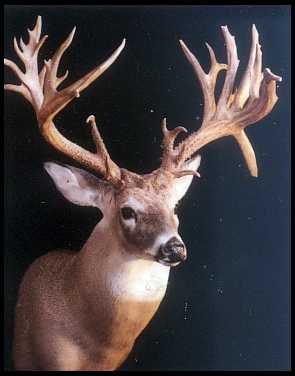Whitetail deer antlers are among nature’s most interesting creations. The first year of birth, a buck develops “buttons” which turn into a small rack, possibly spikes at a year and a half. From then on, things can progress in an orderly fashion or go quite crazy. Bucks tend to develop a consistent antler configuration as they grow older, the reason that shed hunters treasure a multi-year find and often compare them to the animal’s crown at harvest time. Just as some antlers are symmetrical or have one or two variances, others grow racks that become asymmetrical, what deer hunters call “non-typical.” These unusual antlers can be hereditary or form due to injury to the buck. Drop tines and “stickers’ are often a sign of age and form as a buck reaches maturity, however, those racks with 20 or more points occur from a car strike, being wounded during hunting season, fight with another buck, or other trauma. Some deer racks grow non-typical antlers on one side only, an indication that the buck suffered injury to the opposite side.
Jim Smith of Virginia killed a potential world record near my home and it was interesting to see how much attention the deer, and the hunter received. Smith actually hid the rack to make sure that the valuable configuration would not be stolen. It eventually became the number one entry in the non-typical category for bucks taken with black powder. Ironically, Smith had not seen the deer previously nor had any idea of the buck’s enormous rack. Having no luck in the morning, he returned to a stand in the afternoon and the buck chased a doe from the sanctuary of a national park. When Smith walked up on the huge, buck his heart nearly stopped.
This Facebook post tells the story of a possible new world record. Can you imagine walking up on that whitetail monster?
A possible world record whitetail deer was killed in Sumner County on Monday. But it was days in the making. Stephen Tucker, 26, of Gallatin attempted to shoot the trophy buck with a muzzleloader on Saturday, but his gun misfired. He saw the animal again later in the day but was too far away to get what he thought was a clean shot.
“I was just hoping I would see him again after I passed up the shot the second time I saw him,” said Tucker, who estimated he was about 150 yards away at the second sighting. “My thinking was the second time I saw him was as far away as he was and as big as he was, I wanted to make sure that I killed him. I didn’t want to cripple him. I said to myself, ‘If I cripple him, nobody will get to kill him.’ The last thing I wanted to do was be the guy who crippled a deer like that.”



















![The Best Deer Camp Chili [VIDEO] Deer Chili Ingredients, Tomatoes, Chili Spices](/wp-content/uploads/2015/10/Deer-Chili-Deer-Camp-Recipe-218x150.jpg)
![How to Call Elk Early in the Season [VIDEO]](/wp-content/uploads/2016/08/byers003-218x150.jpg)




![Idiots Disturb Hunter: How Would You Have Handled It? [VIDEO]](/wp-content/uploads/2015/10/DSC00110-e1474487693878-100x70.jpg)
![Albino Buck Shocked to Shed His Antlers [VIDEO]](/wp-content/uploads/2015/10/AlbinoDeer-100x70.jpg)